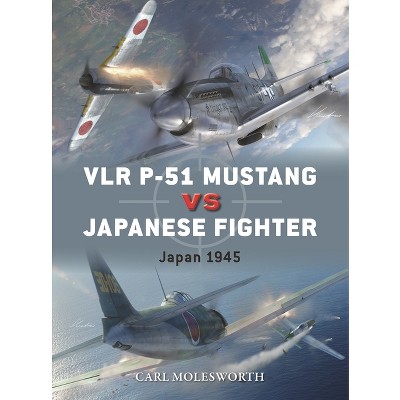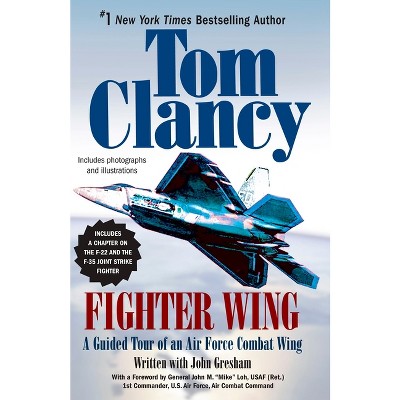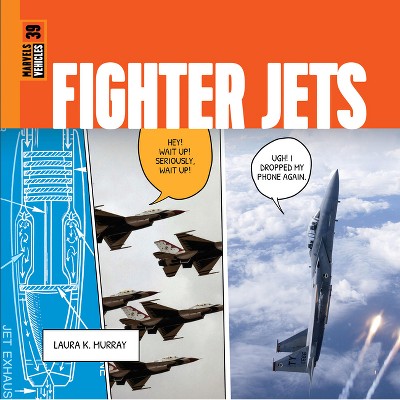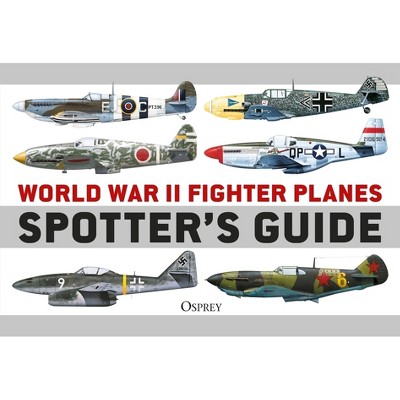Sponsored

Zero Fighter - by Syoko Watanabe (Hardcover)
In Stock
Sponsored
About this item
Highlights
- This technohistory, a genre invented by the author, is the history of the production and use of the famous Zero fighter aircraft, the finest dogfighter in the air for most of World War II.
- About the Author: AKIRA YOSHIMURA invented the technohistory genre which is so popular in Japan and the U.S. Born in Tokyo in 1927, he started to write while a student at Gakushuin University.
- 224 Pages
- History, Military
Description
About the Book
This technohistory, a genre invented by the author, is the history of the production and use of the famous Zero fighter aircraft, the finest dogfighter in the air for most of World War II. Superbly written with an eye to detail and to the poignant and resonant moment, this poetic, highly charged narrative presents World War II from the Japanese point of view. Ultimately more than the history of an airplane--though the Zero is presented with the grandeur due it--this book is an extremely astute presentation of the Japanese character and world view.
From a North American standpoint, Zero Fighter makes a number of highly interesting points, having been written for the Japanese market. For example, North Americans are generally not aware of the success of the Zero fighter or of its significance in Japanese minds. Both the superiority of the aircraft in the early stages of the Pacific War and the great stature of Jiro Horikoshi as an aircraft designer (he is to Japan what the designer of the Spitfire is to the U.K.) will come as a revelation to most readers here.
Also completely unknown to most North American readers is the story of the transport section at the Nagoya Aircraft Works. This information is woven nicely into the book, and has a great deal to say about the startling quality of Japanese wartime industry: rigid in many ways, while producing a plane of brilliant originality. The book is a moving picture of the patience of the Japanese in the face of adversity, but perhaps most important, Zero Fighter>/i> is Japanese. It is not often that a Japanese book is encountered here that divulges intimate knowledge about such a fascinating subject. There is significant value in this as we enter an era in which the Japanese and American people must share and respect the other's cultural point of view.
Book Synopsis
This technohistory, a genre invented by the author, is the history of the production and use of the famous Zero fighter aircraft, the finest dogfighter in the air for most of World War II. Superbly written with an eye to detail and to the poignant and resonant moment, this poetic, highly charged narrative presents World War II from the Japanese point of view. Ultimately more than the history of an airplane--though the Zero is presented with the grandeur due it--this book is an extremely astute presentation of the Japanese character and world view.
From a North American standpoint, Zero Fighter makes a number of highly interesting points, having been written for the Japanese market. For example, North Americans are generally not aware of the success of the Zero fighter or of its significance in Japanese minds. Both the superiority of the aircraft in the early stages of the Pacific War and the great stature of Jiro Horikoshi as an aircraft designer (he is to Japan what the designer of the Spitfire is to the U.K.) will come as a revelation to most readers here. Also completely unknown to most North American readers is the story of the transport section at the Nagoya Aircraft Works. This information is woven nicely into the book, and has a great deal to say about the startling quality of Japanese wartime industry: rigid in many ways, while producing a plane of brilliant originality. The book is a moving picture of the patience of the Japanese in the face of adversity, but perhaps most important, Zero Fighter>/i> is Japanese. It is not often that a Japanese book is encountered here that divulges intimate knowledge about such a fascinating subject. There is significant value in this as we enter an era in which the Japanese and American people must share and respect the other's cultural point of view.From the Back Cover
Akira Yoshimura originally wrote Zero Fighter for the Japanese market, which is actually an interesting perspective for North American audiences to experience. For example, we are generally not aware of the success of the Zero fighter or of its significance in Japanese minds. Both the superiority of the aircraft in the early stages of the Pacific War and the great stature of Jiro Horikoshi as an aircraft designer (he is to Japan what the designer of the Spitfire is to the U.K.) will come as a revelation to most readers here. Also completely unknown to most North American readers is the story of the transport section at the Nagoya Aircraft Works. This information is woven nicely into the book, and has a great deal to say about the startling quality of Japanese wartime industry: rigid in many ways, while producing a plane of brilliant originality. The book is a moving picture of the patience of the Japanese in the face of adversity, but perhaps most important, Zero Fighter is Japanese. It is not often that a Japanese book is encountered here that divulges intimate knowledge about such a fascinating subject. There is significant value in this as we enter an era in which the Japanese and American people must share and respect the other's cultural point of view.Review Quotes
.,."makes a number of highly interesting points...information is woven nicely into the book, and has a great deal to say about the startling quality of Japanese wartime industry....The book is a moving picture of the patience of the Japanese in the face of adversity, but perhaps the most important, Zero Fighter is Japanese. It is not often that a Japanese book is encountered here that divulges intimate knowledge about such a fascinating subject. There is significant value in this as we enter an era in which the Japanese and American people must share and respect each other's cultural point of view."-Asian Reporter
?...makes a number of highly interesting points...information is woven nicely into the book, and has a great deal to say about the startling quality of Japanese wartime industry....The book is a moving picture of the patience of the Japanese in the face of adversity, but perhaps the most important, Zero Fighter is Japanese. It is not often that a Japanese book is encountered here that divulges intimate knowledge about such a fascinating subject. There is significant value in this as we enter an era in which the Japanese and American people must share and respect each other's cultural point of view.?-Asian Reporter
?What readers will gain is not only a historical narrative but how the Japanese view their own technical achievements and limitations....The book is a fascinating read and discusses not only a fighter that would forever be tied to the attack on Pearl Harbor but also other innovations by the Nagoya Aircraft Works.?-Great Lakes Bulletin
?Yoshimura fascinates when recounting how the U.S. ignored early warnings about the Zero from American pilot Claire Chennault, who encountered the remarkable dogfighter while flying for China. He also manages to impart suspense to the oft-told tale of Japan's surprise attack on Pearl Harbor, which occurred three years to the day before an earthquake ravaged the Nagoya Aircraft works, where the Zeros were built--an event that presages not only the end of the war but also the close of Yoshimura's knowledgeable history.?-Publishers Weekly
?Yoshimura invented technohistory as a genre. In this work he deals with the development, production, and history of the Japanese World War II fighter...for all World War II and aviation collections.?-Library Journal
"What readers will gain is not only a historical narrative but how the Japanese view their own technical achievements and limitations....The book is a fascinating read and discusses not only a fighter that would forever be tied to the attack on Pearl Harbor but also other innovations by the Nagoya Aircraft Works."-Great Lakes Bulletin
"Yoshimura fascinates when recounting how the U.S. ignored early warnings about the Zero from American pilot Claire Chennault, who encountered the remarkable dogfighter while flying for China. He also manages to impart suspense to the oft-told tale of Japan's surprise attack on Pearl Harbor, which occurred three years to the day before an earthquake ravaged the Nagoya Aircraft works, where the Zeros were built--an event that presages not only the end of the war but also the close of Yoshimura's knowledgeable history."-Publishers Weekly
"Yoshimura invented technohistory as a genre. In this work he deals with the development, production, and history of the Japanese World War II fighter...for all World War II and aviation collections."-Library Journal
..."makes a number of highly interesting points...information is woven nicely into the book, and has a great deal to say about the startling quality of Japanese wartime industry....The book is a moving picture of the patience of the Japanese in the face of adversity, but perhaps the most important, Zero Fighter is Japanese. It is not often that a Japanese book is encountered here that divulges intimate knowledge about such a fascinating subject. There is significant value in this as we enter an era in which the Japanese and American people must share and respect each other's cultural point of view."-Asian Reporter
About the Author
AKIRA YOSHIMURA invented the technohistory genre which is so popular in Japan and the U.S. Born in Tokyo in 1927, he started to write while a student at Gakushuin University. He has published over 50 books, many of them technohistories. Zero Fighter was a best seller in Japan, selling over 300,000 copies.Shipping details
Return details
Trending Non-Fiction











